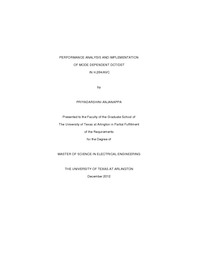
ATTENTION: The works hosted here are being migrated to a new repository that will consolidate resources, improve discoverability, and better show UTA's research impact on the global community. We will update authors as the migration progresses. Please see MavMatrix for more information.
Show simple item record
| dc.contributor.author | Anjanappa, Priyadarshini | en_US |
| dc.date.accessioned | 2013-03-20T19:11:34Z | |
| dc.date.available | 2013-03-20T19:11:34Z | |
| dc.date.issued | 2013-03-20 | |
| dc.date.submitted | January 2012 | en_US |
| dc.identifier.other | DISS-12043 | en_US |
| dc.identifier.uri | http://hdl.handle.net/10106/11546 | |
| dc.description.abstract | Video communications require significant amounts of information transmission. Video compression involves the bitrate reduction of a digital video signal carrying visual information. Compression can be a lossless or a lossy operation. Because of the immense volume of video information, lossy operations are mainly used for video compression. H.264 is a video compression standard that defines a wide set of coding tools to achieve compression. Transform coding is a lossy compression technique that exploits statistical dependencies between image pixels by converting them into coefficients with little or no dependencies. Block transform coding is widely used in image and video compression systems, which makes use of the high degree of correlation between adjacent image pixels to provide energy compaction or coding gain in the transform domain. An integer approximation of DCT-II is used for transform coding in H.264 and also in HEVC, which is the latest upcoming video compression standard. The conventional DCT is implemented through two 1D transforms, one along the vertical direction and another along the horizontal direction. The conventional DCT seems to be the best choice for image blocks in which vertical and/or horizontal edges are dominating. To exploit the redundancies along dominant directions in an image block other than vertical and horizontal, many directional transform schemes were proposed. It is observed that after performing intra prediction, there is still significant directional information left in the prediction residual. To exploit the directionality in the intra prediction residuals, many mode dependent transforms were proposed. The mode dependent DCT/DST is one of them, which was considered during the standardization activities of HEVC. Categorizing the intra prediction directions depending upon whether prediction in an image block is made only from the top row of reference samples or the left column of reference samples or both, DST-VII and DCT-II are adaptively used for the 1D vertical and horizontal transforms. The purpose of this thesis is to revisit this scheme and analyze its performance in H.264 for 4x4 luma intra prediction residuals. HEVC uses DST for 4x4 intra prediction residuals only. The performance of the proposed mode dependent DCT/DST in H.264 is compared with the default H.264 transform implementation and also the latest default HEVC transform implementation. | en_US |
| dc.description.sponsorship | Rao, Kamisetty R. | en_US |
| dc.language.iso | en | en_US |
| dc.publisher | Electrical Engineering | en_US |
| dc.title | Performance Analysis And Implementation Of Mode Dependent DCT/DST In H.264/AVC | en_US |
| dc.type | M.S. | en_US |
| dc.contributor.committeeChair | Rao, Kamisetty R. | en_US |
| dc.degree.department | Electrical Engineering | en_US |
| dc.degree.discipline | Electrical Engineering | en_US |
| dc.degree.grantor | University of Texas at Arlington | en_US |
| dc.degree.level | masters | en_US |
| dc.degree.name | M.S. | en_US |
Files in this item
- Name:
- Anjanappa_uta_2502M_12043.pdf
- Size:
- 2.850Mb
- Format:
- PDF
This item appears in the following Collection(s)
Show simple item record


